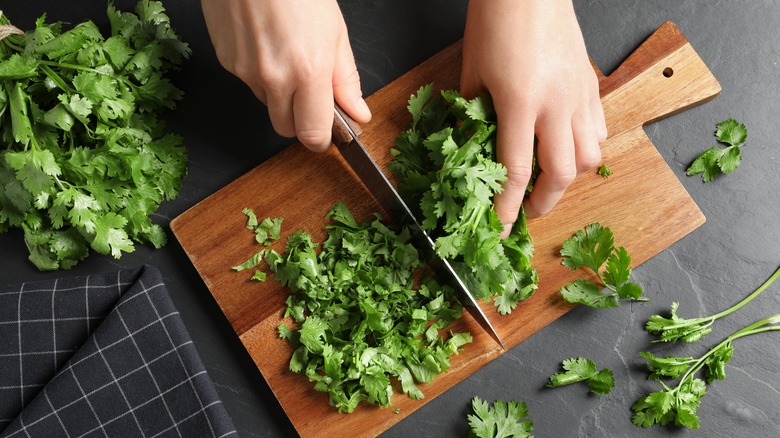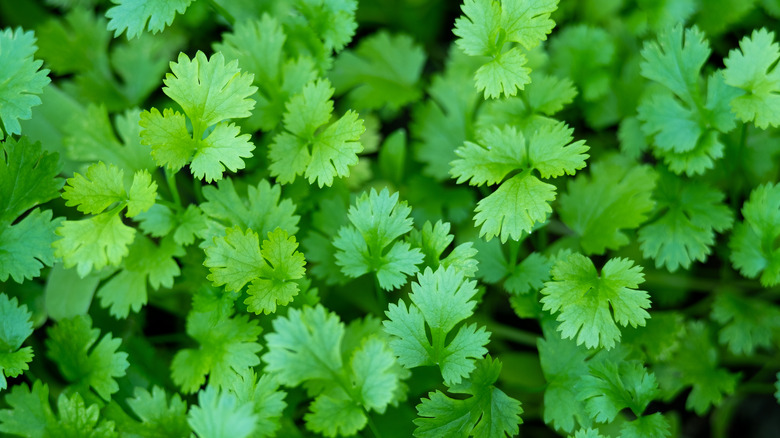The Real Reason Some People Think Cilantro Tastes Like Soap, According To Science
Ah, cilantro: A bright green, fresh, snappy counterpoint to deeper, darker spices, and a critical component in Mexican cuisine, Thai cuisine, Indian cuisine, curries, chutneys, salsas, pestos, seafood dishes, rice dishes, soups, and more. Speaking of the leaves, that is. Take the seeds and ground them down to make the earthy, zingy coriander and you've got a whole other array of dishes at your disposal, like garam masala. Or you know, forget all this culinary nuance because you swear that cilantro is disgusting and tastes like soap.
Anyone who's gone out with friends somewhere and ordered some food, or had folks over the house and cooked a communal meal has likely come across this debate. "Does it have cilantro in it? I hate cilantro. It tastes like soap," the statements might go. To those who love cilantro, all such talk of the herb tasting "like soap" sounds like nonsense. Those who swear it does taste like soap — and who likely have spent some time trying to get it through the heads of all those fools who love it — have to check every label and menu to avoid it like the plague.
But guess what? This is one of those cases where both people are right. In a 2012 study published in the journal Flavour, differences in perception of cilantro taste boiled down to differences in a single DNA base pair on chromosome 11 — specifically, that chromosome's olfactory receptor genes, like gene OR6A2. Smell, in other words.
Genetically predisposed noses
Of course people have all sorts of different preferences and tolerances for food, same as different folks like basketball, hiking, reading, etc., and others don't. But cilantro tasting like soap? That's more than a matter of mere preference. A previous 2012 study published in PLOS One, for instance, discovered a link between the OR7D4 gene — another olfactory gene — and disgust of cooked pork. In particular, those with specific levels of an OR7D4 variant were more sensitive to androstenone and rated meat containing the steroidal pheromone less favorably. Perhaps it's the case that all such food preferences boil down to genetic differences, but such discoveries would be a long way off. As it stands, it's indeed the case that we've cracked the genetically linked soapy cilantro mystery — to a degree.
Folks 400 to 500 years ago were already complaining about cilantro, with John Gerard referring to it as a "very stinking herbe" with a "venemous quality" in "The Herball Or Generall Historie of Plantes." A later 1885 book — M.M. Vilmorin-Andrieux's "The Vegetable Garden" — said that "all the green parts of the plant exhale a very strong odour of the wood-bug." But, those writers were of European descent. And as 23andMe — the company behind the 2012 Flavour study — breaks down, the research found a stark difference in perception of cilantro taste between those with European genetics (13%) and East Asian (8%) and South Asian (4%) genetics. And where in the world did we say that cilantro gets used a lot? Places like India and Thailand.
A complex genetic puzzle
The sense of taste, it's popularly said, relies on smell. While this is true in a general way, data review articles like that on Flavour say that specific percentages — e.g., "75% of flavor comes from smell," or "90% of flavor comes from smell" — have no basis in research. And yet, research like the genetically-induced soapy cilantro study shows how much of an influence smell has on the human sense of taste.
That 2012 study admits that despite boiling cilantro preference down to a specific DNA base pair, it's still not clear how variance in genetics creates the soapy taste that some folks detest. In other words, we know an influencing cause, but not the mechanism of how. To draw a comparison, folks might remember their simple Mendelian genetic chart from grade school, containing "B" (dominant gene) and "b" (recessive gene), right? "Bb" plus "bb," the chart went, equals "brown-eyed baby." Easy, right? Well no. A study in the journal Nature attributes eye color to an interaction between 16 different genes. The point is: Even the most simply-seeming genetics are way, way more complicated than expected. We've cracked the cilantro puzzle, but only a bit.
So what should people do in the meantime? Same as always, we suppose. If you like cilantro, chow down. If you don't, we promise the rest of us won't think you're weird. You just have no control over how things taste to you.


